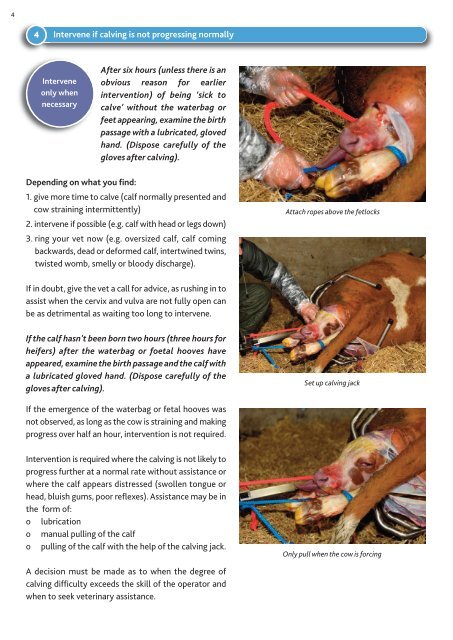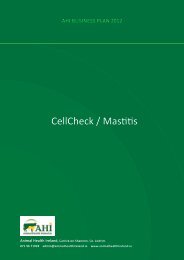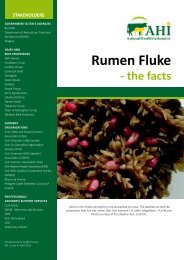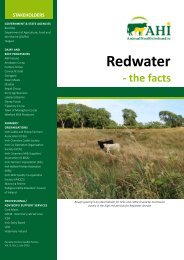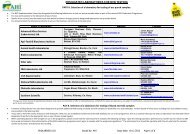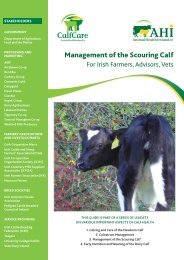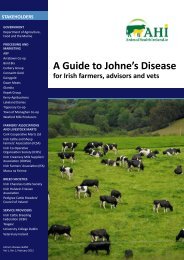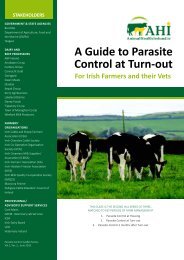Calving and Care of the Newborn Calf - Animal Health Ireland
Calving and Care of the Newborn Calf - Animal Health Ireland
Calving and Care of the Newborn Calf - Animal Health Ireland
Create successful ePaper yourself
Turn your PDF publications into a flip-book with our unique Google optimized e-Paper software.
4<br />
4<br />
Intervene if calving is not progressing normally<br />
Intervene<br />
only when<br />
necessary<br />
After six hours (unless <strong>the</strong>re is an<br />
obvious reason for earlier<br />
intervention) <strong>of</strong> being ‘sick to<br />
calve’ without <strong>the</strong> waterbag or<br />
feet appearing, examine <strong>the</strong> birth<br />
passage with a lubricated, gloved<br />
h<strong>and</strong>. (Dispose carefully <strong>of</strong> <strong>the</strong><br />
gloves after calving).<br />
Depending on what you find:<br />
1. give more time to calve (calf normally presented <strong>and</strong><br />
cow straining intermittently)<br />
2. intervene if possible (e.g. calf with head or legs down)<br />
3. ring your vet now (e.g. oversized calf, calf coming<br />
backwards, dead or deformed calf, intertwined twins,<br />
twisted womb, smelly or bloody discharge).<br />
If in doubt, give <strong>the</strong> vet a call for advice, as rushing in to<br />
assist when <strong>the</strong> cervix <strong>and</strong> vulva are not fully open can<br />
be as detrimental as waiting too long to intervene.<br />
If <strong>the</strong> calf hasn't been born two hours (three hours for<br />
heifers) after <strong>the</strong> waterbag or foetal hooves have<br />
appeared, examine <strong>the</strong> birth passage <strong>and</strong> <strong>the</strong> calf with<br />
a lubricated gloved h<strong>and</strong>. (Dispose carefully <strong>of</strong> <strong>the</strong><br />
gloves after calving).<br />
If <strong>the</strong> emergence <strong>of</strong> <strong>the</strong> waterbag or fetal hooves was<br />
not observed, as long as <strong>the</strong> cow is straining <strong>and</strong> making<br />
progress over half an hour, intervention is not required.<br />
Intervention is required where <strong>the</strong> calving is not likely to<br />
progress fur<strong>the</strong>r at a normal rate without assistance or<br />
where <strong>the</strong> calf appears distressed (swollen tongue or<br />
head, bluish gums, poor reflexes). Assistance may be in<br />
<strong>the</strong> form <strong>of</strong>:<br />
o lubrication<br />
o manual pulling <strong>of</strong> <strong>the</strong> calf<br />
o pulling <strong>of</strong> <strong>the</strong> calf with <strong>the</strong> help <strong>of</strong> <strong>the</strong> calving jack.<br />
A decision must be made as to when <strong>the</strong> degree <strong>of</strong><br />
calving difficulty exceeds <strong>the</strong> skill <strong>of</strong> <strong>the</strong> operator <strong>and</strong><br />
when to seek veterinary assistance.<br />
Attach ropes above <strong>the</strong> fetlocks<br />
Set up calving jack<br />
Only pull when <strong>the</strong> cow is forcing


